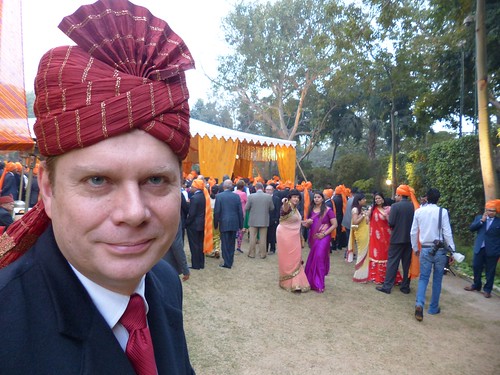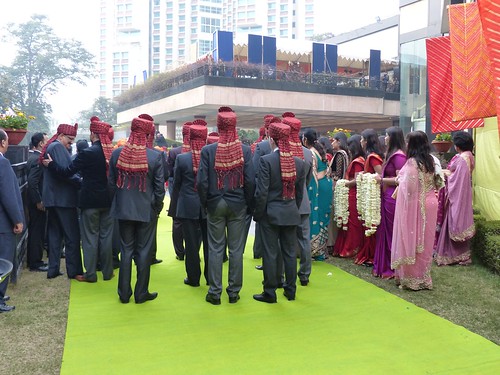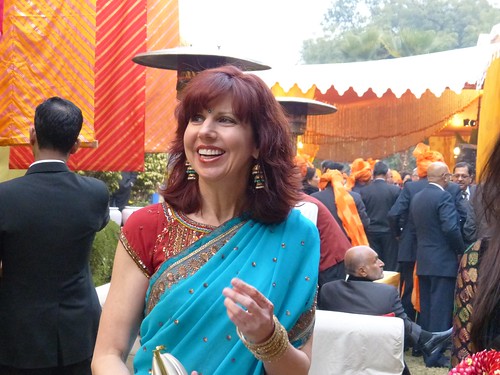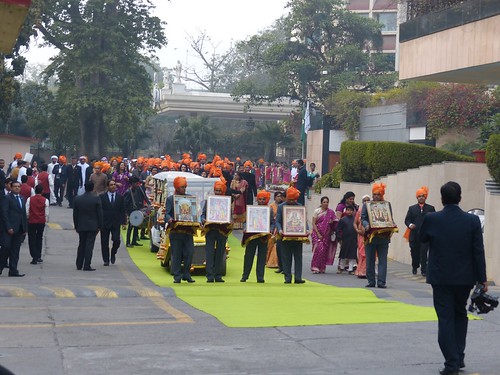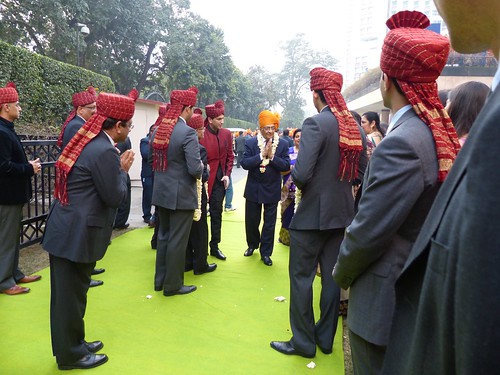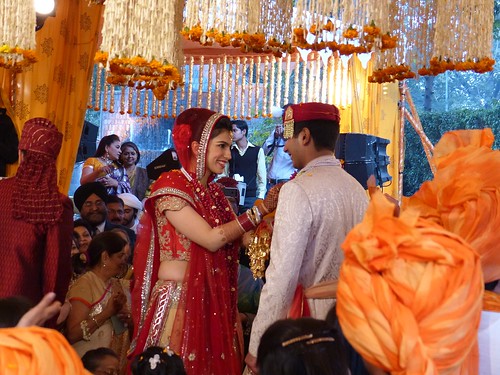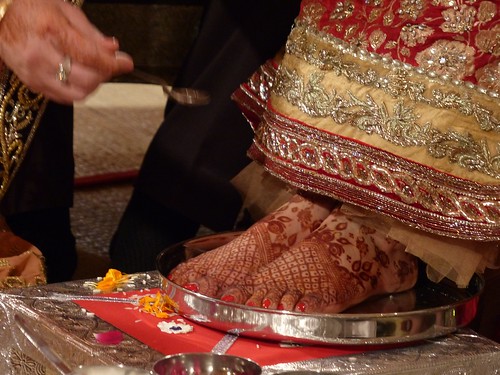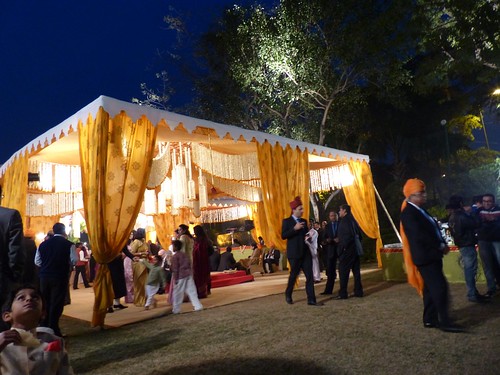Our wonderful week of wedding festivities flew by, and I found myself consumed by work and other obligations before I had finished blogging about the wedding day itself. So here goes.
Sanna and Madhavkrishna tied the knot at the Shangri La Hotel on Thursday, Jan. 31. Tony and I arrived on time, having missed ceremonies and performances Monday and Wednesday in our attempt to be fashionably late. At the hotel, we were directed to follow the lime green carpet to a spot where Sanaa’s family lingered excitedly. They encouraged us to stand with them to receive the “baraat.” The entrance to the venue featured musicians playing a drum (called a dhol) and an auspicious traditional oboe (called a shehnai).
Posing with the musicians in my borrowed sari.
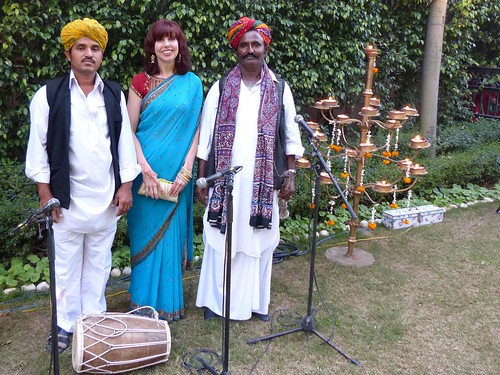
The baraat is a procession that brings the groom to the wedding venue. We’ve seen many of these processions around Delhi, often with the groom riding a white mare and accompanied by drummers and dancers. In this case, the groom arrived in a golf cart, preceded by a row of men carrying paintings of Hindu gods, and surrounded by revelers. His close male friends and family members sported bright orange turbans, while those on the bride’s side wore burgundy turbans. We later found out the turbans were a sign of honor, so we were touched that Sanaa’s brother, Karan, placed one on Tony’s head.
When the baraat arrived, we watched Sanaa’s parents greet Madhav’s parents and other relatives ceremoniously with garlands.
After all the groom’s guests had proceeded to the huge tent, the bride’s mother Alka started looking anxious. She craned her neck to see the hotel’s entrance, and then told us it was time for Sanaa to make her entrance. Finally, she emerged under a veil of flowers, flanked by her brother on one side and a girlfriend on the other. They walked her to a stage in the tent, where she and Madhav exchanged garlands.
Researching the rituals of an Indian wedding is like trying to categorize India itself. The answers only lead to more questions. Hindus from different regions celebrate in different ways. At one point, even Sanaa’s brother couldn’t tell me what was going on. Sanaa’s parents sat with Madhav for quite a long time, following the priest’s directions, which included sprinkling various things on the groom’s hands and feet. I snapped a few photos, but I had no idea what I was shooting. After awhile, Sanaa was escorted over to join them, and a number of other rituals took place, some involving her beautifully hennaed feet.
Next, they performed “pheras,” circling a pious fire seven times. According to Wikipedia (which aligned with several Indian culture websites but with better English):
1. In the first round or phera, the couple prays to God for plenty of nourishing and pure food. They pray to God to let them walk together so that they will get food.
2. In the second round, the couple prays to God for a healthy and prosperous life. They ask for the physical, spiritual and mental health from God.
3. In the third phera the couple prays to God for wealth. They ask God for the strength for both of them so that they can share the happiness and pain together. Also, they pray so that they can walk together to get wealth.
4. In the fourth round the couple prays to God for the increase in love and respect for each other and their respective families.
5. The bride and groom together pray for the beautiful, heroic and noble children from God in the fifth step.
6. In the sixth holy round around the fire, the couple asks for the peaceful long life with each other.
7. In the final seventh round the couple prays to god for companionship, togetherness, loyalty and understanding between themselves. They ask God to make them friends and give the maturity to carry out the friendship for lifetime. The husband says to his new wife that now they have become friends and they will not break their friendship in life.
Congratulating the proud papa.
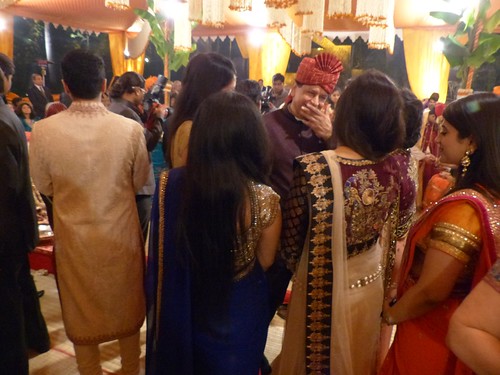
Jasmine and marigolds everywhere!
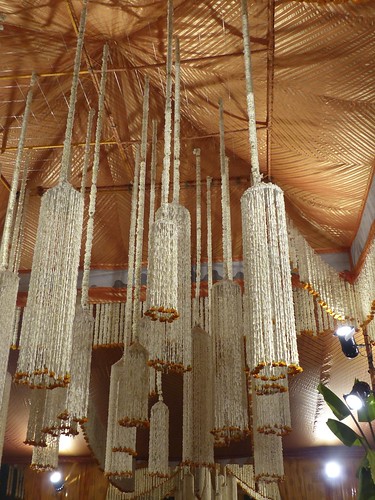
We left after the three-hour ceremony but before the dinner. (It was a school night!) Tony and I both feel deeply honored and grateful for the opportunity to participate in this gorgeous cultural experience, and we wish a lifetime of happiness to Sanaa and Madhav.

